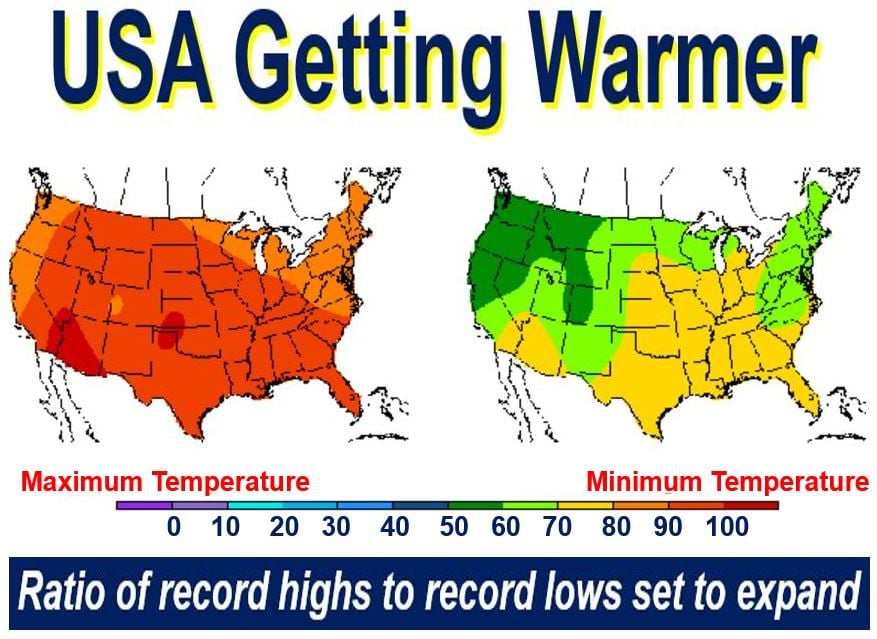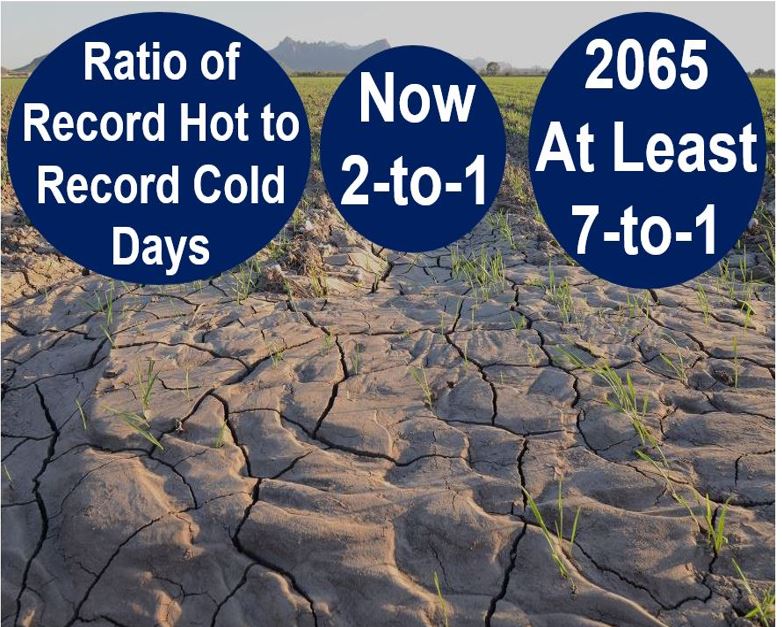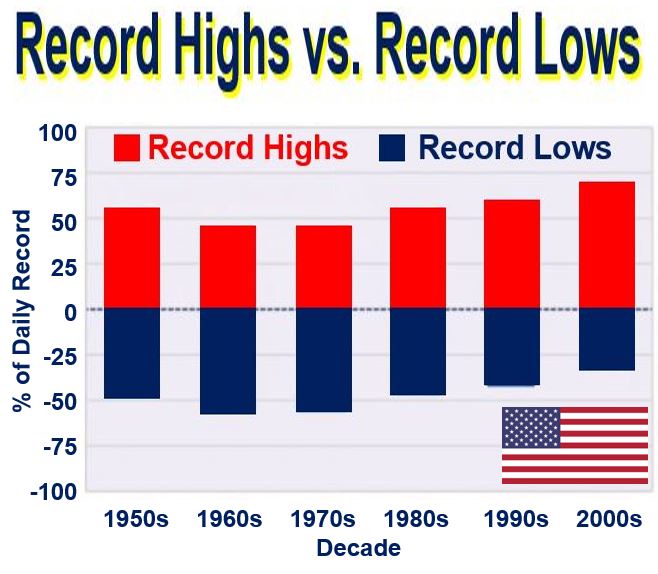The number of record-breaking heat days in the US has been increasing progressively over the last couple of decades, and will become more frequent and intense as humans continue pumping greenhouse gases into the atmosphere, a new study warns.
A study led by the National Center for Atmospheric Research (NCAR) and published in Proceedings of the National Academy of Sciences (PNAS, citation below), informs that it won’t be long before Americans experience approximately fifteen days of record-breaking heat for every single record-breaking cold day.
In normal times, the frequency of record-breaking heat and record-breaking cold days should be evenly balanced – when there are 10 of one there are 10 of the other, etc. This is just not happening any more. For over forty years, the balance has been gradually tilting towards more and more days of record-breaking heat.
 The US has experienced abnormal warmth recently, as this July 22, 2016, weather map indicates. Much of the country faces highs in the low nineties and hundreds and lows in the seventies. Recent research suggests that more days of record-breaking heat are in store. (Image: ucar.edu. Credit: Weather Map by NOAA’s Weather Prediction Center)
The US has experienced abnormal warmth recently, as this July 22, 2016, weather map indicates. Much of the country faces highs in the low nineties and hundreds and lows in the seventies. Recent research suggests that more days of record-breaking heat are in store. (Image: ucar.edu. Credit: Weather Map by NOAA’s Weather Prediction Center)
The ratio of record hot and record cold days could also turn out to be greater if the pace of greenhouse gas emissions increases and triggers even more warming, the researchers warned.
Over the last ten years, the ratio of days with record-breaking heat to record-breaking cold has averaged approximately 2-to-1.
NCAR senior scientist and lead author, Dr. Gerald Meehl, said:
“More and more frequently, climate change will affect Americans with record-setting heat. An increase in average temperatures of a few degrees may not seem like much, but it correlates with a noticeable increase in days that are hotter than any in the record, and nights that will remain warmer than we’ve ever experienced in the past.”
The fifteen-to-one ratio of record-breaking heat to cold is based on temperatures across the continental US rising by marginally more than 3°C (5.4°F) above recent years. Scientists expect temperatures to rise by that amount if we continue emitting greenhouse gases at our current rate.
 The seven-to-one ratio by 2065 is the conservative estimate – it could go up to 22-to-1, if our current greenhouse gas emissions do not change. (Image: carbonbrief.org)
The seven-to-one ratio by 2065 is the conservative estimate – it could go up to 22-to-1, if our current greenhouse gas emissions do not change. (Image: carbonbrief.org)
Days of record-breaking heat
Dr. Meehl was part of a 2009 study team that found that the ratio of record high to record low daily temperatures had been steadily slanting towards record hot since the 1970s as average temperatures across the USA have risen.
According to computer models at that time, the ratio would most likely continue expanding during this century, although Dr. Meehl and colleagues only looked at one scenario of future greenhouse gas emissions.
The researchers also found that their models had been overstating the ratio of days of record-breaking heat to days of record-breaking cold in recent years, compared to observations that were made.
After digging deeper into the issue and analyzing why the models and observations differed, Dr. Meehl and his co-authors say they now have a more accurate projection of future record-breaking heat events (daily highs) across the United States.
Their current projections are based on the average temperature rise over mainland USA, rather than on a particular scenario of future greenhouse gas emissions.
 This image shows the % of daily temperature records set at weathers stations across the continental USA by decade. (Image: twitter.com./AtmosNews. Credit: US EPA from Meehl et al., 2009)
This image shows the % of daily temperature records set at weathers stations across the continental USA by decade. (Image: twitter.com./AtmosNews. Credit: US EPA from Meehl et al., 2009)
3°C rise in temperature by 2065
In fifty years’ time (by 2065), temperatures across the United States will increase by an average of slightly more than 3°C (5.4°F) if we keep pumping out greenhouse gases at our current rate.
In this kind of scenario, the ratio of days with record-breaking heat to cold will probably be about 15-to-1. The ratio could range anywhere from a whopping 22-to-1 to 7-to-1. Whatever it ends up being, it will be considerably hotter than the current 2-to-1.
If temperatures rise by more than 3°C, the ratio will jump significantly. For example, an increase of 4°C (7.2°F) would mean having to endure a ratio of 38-to-1.
Such a scenario is very possible, especially if no measures are taken to reduce greenhouse gas emissions.
Dr. Meehl said:
“Every degree of warming makes a substantial amount of difference, with the ratio of record highs to record lows becoming much greater.”
“Even with much warmer temperatures on average, we will still have winter and we will still get record cold temperatures, but the numbers of those will be really small compared to record high maximums.”
Get used to heat records; study predicts far more in future #NCARscience via @AP @borenbears https://t.co/AwsCHSdkHR
— NCAR & UCAR Science (@AtmosNews) November 21, 2016
Record-breaking heat days here to stay
The United States is already far from a normal 1-to-1 ratio, which would be the case if temperatures were not warming. Days of record-breaking heat are becoming more common all over the country.
Over the past decade, the ratio has averaged approximately 2-to-1. However, there is significant year-to-year variation. In 2012, the ratio was 5-to-1, it then dipped to 1-to-1 for the next two years, and then jumped to nearly 3-to-1 in 2015.
The abnormal warmth of 2016, caused by both El Niño and climate change caused by humans, has so far resulted in 25,519 days of record-breaking heat versus 3,970 days of record-breaking cold. This year will see a ratio of about six-to-one.
The warm 1930s and precipitation
A major part of this latest study involved finding out why the 2009 models were simulating greater record heat-to-cold days compared to recent observations, even though there was overall agreement between the models and observed declines in days of record-breaking lows.
Dr. Meehl and colleagues concentrated on two sets of simulations carried out on the NCAR-based Community Climate System Model (version four), which was funded by NSF (National Science Foundation) and DOE (Department of Energy), and developed by climate scientists across the USA.
Their analysis found two reasons for the discrepancy between the observations and the computer models.
– Precipitation: this was underestimated in the models. Because air temperature is cooled by precipitation and resulting evapotranspiration – the release of moisture from plants and the land back to the atmosphere – the computer models tended to create overly dry environments, which led to more days of record-breaking heat.
– Time Span: the 2009 study only went back to the 1950s. In this latest research, the scientists went back to the 1930s, i.e. to when accurate record-keeping started.
In the 1930s, during the Dust Bowl days, the number of days of record-breaking heat was unusually high, which made it difficult in subsequent years to get many record-breaking days, even as temperature rose.
However, even when taking into account what happened in the 1930s, the model-simulated and observed ratio of record highs to lows have been increasing.
Dr. Claudia Tebaldi, a project scientist at the Climate and Global Dynamics Laboratory at NCAR/*UCAR, said:
“The steady increase in the record ratio is an immediate and stark reminder of how our temperatures have been shifting and continue to do so, reaching unprecedented highs and fewer record lows.”
“These changes pose adaptation challenges to both human and natural systems. Only a substantial mitigation of greenhouse gas emissions may stop this increase, or at least slow down its pace.”
* UCAR stands for University Corporation for Atmospheric Research.
This study was funded by the DOE an NSF.
Citation: “US daily temperature records past, present, and future,” Gerald A. Meehla, Claudia Tebaldia, and Dennis Adams-Smith. Proceedings of the National Academy of Sciences (PNAS). November 21, 2016. DOI: 10.1073/pnas.1606117113.
Video – How climate change is affecting the USA
In this Daily Conversation video, Dr. John Holdren, President Obama’s Science Advisor, says that climate change is not a distant threat – it is affecting the American people already. He goes on to talk about the future impact of climate change on our planet’s resources.
